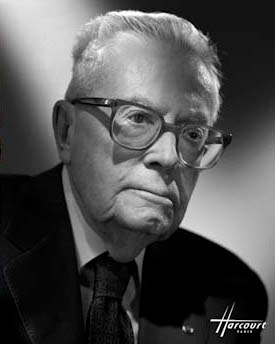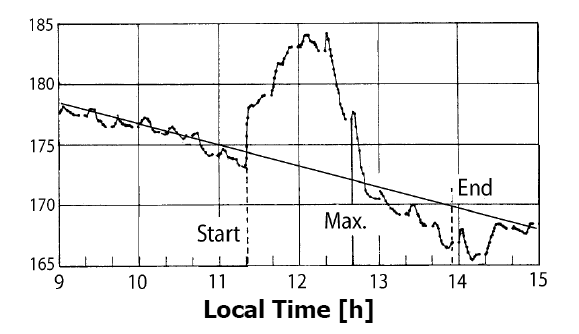| Tikalon Blog is now in archive mode.
An easily printed and saved version of this article, and a link
to a directory of all articles, can be found below: |
|
This article |
| Directory of all articles |
Maurice Allais
October 13, 2010
Maurice Allais, winner of the 1988
Nobel Memorial Prize in Economics for "pioneering contributions to the theory of markets and efficient utilization of resources," died on October 9, 2010, at age 99.[1-4] Aside from his accomplishments in
economics, Allais is known to physicists for the invention of the
paraconical pendulum and its use during the June 30, 1954,
solar eclipse in the discovery of the still unconfirmed
Allais Effect.[5-6]

(Photograph by Studio Harcourt Paris)
Allais was trained as an
engineer at the
Ecole Polytechnique, graduating first in his class in 1933, and then working as a mining engineer. A visit to the United States during the
Great Depression and seeing the country as "a graveyard of factories" inspired him to pursue economics in order to "improve the conditions of life, to try to find a remedy to many of the problems facing the world." His engineering training was put to good use in forming mathematical models on pricing. The
Nobel Prize web site contains autobiographies of its laureates, and Allais' entry states that he would have become a physicist if CNRS, the
French National Centre for Scientific Research, had existed in 1938. In a book entitled, "The World Crisis Today," Allais called for reform of the world's financial and monetary systems after the 1998 world
financial crisis. The world, of course, ignored his advice (written in French) to its current peril.
Allais wrote more than 1,000 articles, authored more than a score of books, and he's famous for several economic principles. Since he published exclusively in French, many of his discoveries were unknown and were independently made by others, including another Nobel Laureate,
Paul Samuelson. He's most commonly associated with the "Allais Paradox," which simply states that people do not rotely follow what's mathematically calculated to be their best interest. An example of this is whether you would take a cash award of $100 over a 50:50 chance at getting $210. Most people will take the cash over the chance, although "economic sense" predicts a better average outcome with the chance.
Allais discovered what's known as the "Golden Rule" of economic growth, that real income accumulation is optimized when the interest rate is equal to the growth rate. He also proved the correctness of the "invisible hand" conjecture expressed in
Adam Smith's The Wealth of Nations,
"It is not from the benevolence of the butcher, the brewer, or the baker, that we expect our dinner, but from their regard to their own interest. We address ourselves, not to their humanity but to their self-love, and never talk to them of our own necessities but of their advantages."
Physical scientists will likely be more interested in Allais' extracurricular work in physics. Following the tradition of his countryman,
Foucault, he invented a new type of pendulum apparatus called a
paraconical pendulum. The distinguishing feature of this pendulum is that it pivots on a ball resting on a plate (see figure). The attachment to the pendulum bob is a rigid rod, and the bob is shaped to reduce air resistance. Because of this particular attachment, the pendulum can rotate around a plane orthogonal to its swinging motion. This pendulum is so sensitive that the rotation of the ball has a 24.8 hour period because of the
tidal affect of the
moon.

Paraconical pendulum.
Allais recorded data from a paraconical pendulum during the June 30, 1954, solar eclipse. There was an anomalous shift in pendulum angle that coincided with the eclipse (see figure), and he measured the same effect during a solar eclipse in 1959. He conjectured that he had discovered a spatial anisotropy that harked back to
aether theories of
mechanics. Physicists, of course, were skeptical, and there have been experiments to elucidate the effect at every solar eclipse since that time. None of these have been conclusive, and the entire history of this "
Allais Effect" reads like that of
cold fusion. A possible explanation, which is reminiscent of the actual affect
sunspots have on the
length of day,[7] is that it's caused by the gravitational effect of increased atmospheric density caused by cooling during an eclipse.[8]

Allais' data for the June 30, 1954, solar eclipse. The vertical axis is the azimuth angle of the pendulum in grads with a linear trend line. The start, maximum and end of the eclipse are noted. (From M.F.C. Allais, "Should the Laws of Gravitation be reconsidered? part 1," Aero/Space Engineering, September, 1959, via arXiv [9]).
References:
- Maurice Allais autobiography on the Nobel Foundation web site.
- Douglas Martin, "Maurice Allais, Nobel Winner, Dies at 99," New York Times, October 11, 2010.
- Maurice Allais, BBC News, October 11, 2010.
- Maurice Allais Obituary, Legacy.com (October 11, 2010).
- Leslie Mullen, "Decrypting the Eclipse," NASA, August 6, 1999.
- Allais effect page on Wikipedia
- This Blog, "Length of Day," September 9, 2010.
- T. Van Flandern and X. S. Yang, "Allais gravity and pendulum effects during solar eclipses explained," Phys. Rev. D, vol. 67, no. 2 (January 15, 2003), Article 022002 (6 pages).
- Chris P. Duif, "A review of conventional explanations of anomalous observations during solar eclipses," arXiv Preprint, December 31, 2004.
Permanent Link to this article
Linked Keywords: Maurice Allais; Nobel Memorial Prize in Economics; economics; paraconical pendulum; solar eclipse; Allais Effect; engineer; Ecole Polytechnique; Great Depression; Nobel Prize; CNRS; French National Centre for Scientific Research; financial crisis; Paul Samuelson; Adam Smith; The Wealth of Nations; Foucault pendulum; paraconical pendulum; tidal affect; moon; aether theories; mechanics; cold fusion; sunspots; length of day; grads.